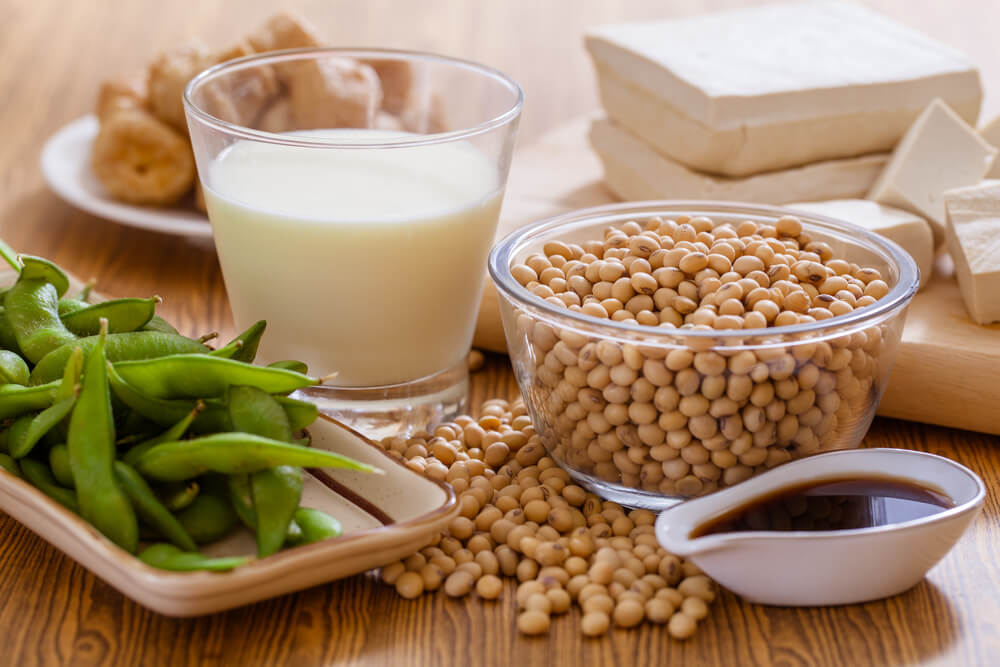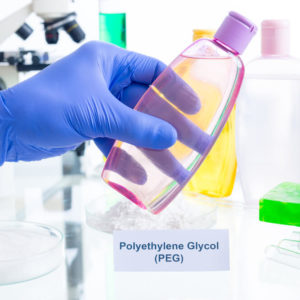
There was a time when soy was praised a “super food,” from combating cancer to reducing high cholesterol. However, new evidence has emerged with soy’s negative impact on health (and the environment), which has got a majority of us reconsidering our consumption of products like tofu and soy milk.
Here are 5 health issues concerning soy consumption:
1. Impaired immune system
Soy contains endocrine disrupting chemicals called phytoestrogens (specifically Genistein and daidzein) (1, 2, 3). They influence the reproductive organs as well as the immune system. In one study they found that mice treated with genistein (soy isoflavone) had less interferon (IFN)-gamma in culture supernatants (4) compared to mice treated with oil. Interferon-gamma is a cytokine that is crucial in innate and adaptive immunity against viral and bacterial infections and tumour control. Decreased levels of this molecule mean decreased immunity and decreased tumour control.
2. Impaired Fertility
Soy isoflavones as seen in point 1 (above), are structurally similar to endogenous estrogens and display both estrogenic and weak anti-estrogenic activities (5). Impaired fertility and reproductive tract disorders can be a result of said activities. In female rats exposed to high doses of isoflavones their fertility decreased (6, 7) and had altered estrous cycling (8) – it also led to increased uterine weight and epithelial cell height which may contribute to ovarian cysts. Studies done with male rats had no found effects on sexual maturity, preputial separation, fertility, sperm count or testosterone levels (8).
3. Thyroid Disorders
Soy-containing foods and their isoflavones may adversely affect thyroid function. In one study they investigated whether breast and soy-containing formula feedings in infants were associated with development of autoimmune thyroid disease in the children (9). “There was no difference in the frequency and duration of breast feeding in early life among the three groups of children. However, the frequency of feedings with soy-based milk formulas in early life was significantly higher in children with autoimmune thyroid disease (prevalence 31%) as compared with their siblings (prevalence 12%; chi 2 = 7.22 with continuity factor; p less than 0.01), and healthy nonrelated control children (prevalence 13%, chi 2 = 5.03 with continuity factor; p less than 0.02)” (9). This suggests that feeding infants soy formula is associated with autoimmune thyroid disease in the early years.
Another study found that compounds in acidic methanol extracts of soybeans inhibit thyroid peroxidase- (TPO) catalyzed reactions required for normal thyroid hormone synthesis (10). Inhibition of thyroid hormone synthesis can lead to goiter and thyroid neoplasia.
4. Brain Damage
In major study including 3,734 elderly Japanese-American men, those who consumed most soy during their midlife had a 2.4 times higher risk of developing Alzheimer’s disease later in their life (11, 12). These men consumed tofu at least twice a week and had more cognitive impairment than those who never ate or only sporadically consumed tofu.
These researchers also found that high consumption of tofu during midlife was associated with lower brain weight. 574 of the men were assessed for brain atrophy using an MRI machine, and although brain shrinkage naturally occurs with age, those men who ate more tofu had “an exaggeration of the usual patterns we see in aging” (11, 12).
5. Infant Abnormalities
Problems regarding infants and soy is an important topic, especially for mothers who choose to use soy-infant formulas instead of breast feeding. According to Mary G. Enig, Ph.D., “the amount of phytoestrogens that are in a day’s worth of soy infant formula equals 5 birth control pills.”
Soy-infant formulas contain high levels of isoflavones, and exposing infants to this daily intake equivocates to a 6-11 fold higher isoflavone exposure (based on bodyweight) than the dose that creates hormonal changes in adults consuming soy foods. When infants were tested for isoflavone concentrations circulating in the blood, the levels were 13,000-22,000 times higher than natural estrogen concentrations in the early years (13, 14).
5 of The Biggest Problems Surrounding Soy:
1. Genetic Modification (GMOs)
Did you know that up to 91% of soy grown in the U.S. is genetically modified (GM)? The soybeans are specially selected so that they will resist the toxic herbicide Roundup. This means that the soybeans themselves are loaded with this toxic pesticide. In addition, genes from bacteria that produce a protein foreign to the human food supply are also inserted into the genes of the soybean plant, making this food item an un-natural food supply.
2. Contains Toxins: “anti-nutrients”; hemagglutinin; goitrogens; phytates
Anti-nutritional factors like saponins, soyatoxin, phytates, protease inhibitors, oxalates, goitrogens and estrogens all interfere with our protein-digesting enzymes and result in poor digestion and thus poor health.
Soybeans also contain hemagglutinins which act as clot-inducing substances (causes red blood cells to stick together). This makes our red blood cells unable to absorb oxygen and distribute it throughout the body.
Goitrogens are a category of foods that promote formation of goiter (enlarged thyroid) – and soy foods fall in that category. They block thyroid hormone synthesis and obstruct iodine metabolism.
The soybean has one of the highest phytate levels of any grain or legume. Phytates prevent the absorption of minerals like calcium, magnesium, iron and zinc by binding to the metal ions and preventing them from entering the cells of your body. As many vegans consume soybean products, and depend on them for absorption of these exact minerals, they may be doing just the opposite.
3. Contains Isoflavones
Soy contains the isoflavones genistein (as seen previously) and daidzein. Isoflavones are a type of phytoestrogen which resemble the human compound called estrogen. Phytoestrogens have been found to block the hormone estrogen and can have serious effects on human tissues such as disrupting endocrine function, causing infertility, and promoting breast cancer in women.
4. Toxic Levels of Aluminum & Manganese
Aluminum tanks are used to process and acid-wash soybeans before consumption. Aluminum particles from the tanks are directly absorbed into the soybean, and result in high aluminum concentrations in the bean. Soy infant formula also contains manganese levels 80 times higher than that found in human breast milk (15, 16).
5. Soy Infant Formula Concerns
The isoflavones in soy infant formula is of great concern to new and expecting parents who choose to bottle-feed instead of breast-feed. Nearly 20% of U.S. infants are bottle-fed soy formula. As seen throughout this article, it is clear that the isoflavones in soy formula can negatively impact your child’s health (impairing sexual development and reproductive health).
Soy Products That Are Good For You
Choose fermented soy products such as:
1. Tempeh – fermented soybean cake that is firm and has a nutty, mushroom-like flavor
2. Miso – fermented soybean paste that is quite salty and commonly used in miso soup
3. Natto – sticky fermented soybeans with a strong, cheesy flavor
4. Soy Sauce – fermented soybeans, salt & enzymes
Soy Products To Avoid:
Try to avoid the following soy products if they’re not fermented or organic:
– Tofu
– TVP (texturized vegetable protein) or soy protein isolate
– Soybean oil
– Soymilk
– Soy cheese, soy ice cream, soy yogurt
– Soy “meat”
– Soy protein
– Edamame
– Soy infant formula
– Avoid ALL processed foods, and purchase only whole foods prepared by yourself! Many packaged food products contain soy.
What Should You Eat Instead Of Soy?
Many vegans consume “mock meat” typically made out of soybeans that are not fermented. As an alternative to the above list you can eat:
– Tofu – Instead, eat tempeh (it is similar, just more dense)
– Soybean oil – Instead, use olive oil, hemp seed oil, coconut oil, etc.
– Soymilk – Instead, drink hemp, rice, almond, coconut or oat milk
– Soy cheese, soy ice cream, soy yogurt – Instead eat Daiya cheese (much better than soy cheese), and coconut or banana ice cream (you can use bananas as a yogurt too if you wanted – just mash them up!)
– Soy “meat” – Instead, eat tempeh
– Soy protein – Instead, eat heart-healthy, amino-acid packed hemp protein
– Soy infant formula – Instead, use infant formulas that are soy-free
Sources:
(1) Colborn, T., Vom Saal, F., & Soto, A. (1993) Developmental effects of endocrine-disrupting chemicals in wildlife and humans. Environmental Health Perspectives, 101, 378-384.
(2) Poon, B., Leung, C., Wong, C., & Wong, M. (2005) Polychlorinated biphenyls and organochlorine pesticides in human adipose tissue and breast milk collected in Hong Kong. Archives of Environmental Contamination and Toxicology, 49, 274-282.
(3) Irvine, C., Shand, N., Fitzpatrick, M., & Alexander, S. (1998). Daily intake and urinary excretion of genistein and daidzein by infants fed soy- or dairy-based infant formulas. American Journal of Clinical Nutrition, 68, 1462-1465.
(4) Calemine, J., Zalenka, J., Karpuzoglu, E., Ward, D., Lengi, A., & Ahmed, S. (2003) The immune system of geriatric mice is modulated by estrogenic endocrine disruptors (diethylstillbestrol, alpha-zearalanol, and genistein): effects on interferon-gamma. Toxicology, 194, 115-128.
(5) Mitchell, J., Cawood, E., Kinniburgh, D., Provan, A., Collins, A., & Irvine, S. (2001) Effect of a phytoestrogen food supplement on reproductive health in normal males. Clinical Science, 100, 613-618.
(6) Jefferson, W., Padilla-Banks, E., & Newbold, R. (2005) Adverse effects on female development and reproduction in CD-1 mice following neonatal exposure to the phytoestrogen genistein at environmentally relevant doses. Biology of Reproduction, 73, 798-806.
(7) Jefferson, W., Padilla-Banks, E., Goulding, E., Lao, S., Newbold, R., & Williams, C. (2009) Neonatal exposure to genistein disrupts ability of female mouse reproductive tract to support preimplantation embryo development and implantation. Biology of Reproduction, 80, 425-431.
(8) Dinsdale, E., & Ward, W. (2010) Early exposure to soy isoflavones and effects on reproductive health: a review of human and animal studies. Nutrients, 2, 1156-1187.
(9) Fort, P., Moses, N., Fasano, M., Goldberg, T., & Lifshitz, F. (1990) Breast and soy-formula feedings in early infancy and the prevalence of autoimmune thyroid disease in children. Journal of The American College of Nutrition, 9, 164-167.
(10) Divi, R., Chang, H., & Doerge, D. (1997) Anti-thyroid isoflavones from soybean: isolation, characterization and mechanisms of action. Biochemical Pharmacology, 54, 1087-1096.
(11) White, L., Petrovich, H., Ross, G., & Masaki, K. (1996) Association of mid-life consumption of tofu with late life cognitive impairment and dementia: the Honolulu-Asia aging study. Fifth International Conference on Alzheimer’s Disease, 487.
(12) White, L., Petrovich, H., Ross, G., Masaki, K., Hardman, J., Nelson, J., Davis, D., & Markesbery, W. (2000) Brain, aging and midlife tofu consumption. Journal of The American College of Nutrition, 19, 242-255.
(13) Cassidy, A., Bingham, S., & Setchell, K. (1994) Biological effects of a diet of soy protein rich in isoflavones on the menstrual cycle of premenopausal women. American Journal of Clinical Nutrition, 60, 333-40.
(14) Setchell, K., Zimmer-Nechemias, L., Cai, J., & Heubi, J. (1997) Exposure of infants to phyto-estrogens from soy-based infant formula. Lancet, 350, 23-27.
(15) McGraw, M., Bishop, N., Jameson, R., Robinson, M., O’Hara, M., Hewitt, C., & Day, J. (1986) Aluminum content of milk formulae and intravenous fluids used in infants. Lancet, 1, 157.
(16) Dabeka, R., & McKenzie, A. (1987) Lead, cadmium, and fluoride levels in market milk and infant formulas in Canada. J Assoc Off Anal Chem, 70, 754-57.








[…] cheese substitutes There are so many cheese substitutes out there – I would suggest trying to stay away from the soy-based cheeses, and stick with those produced by companies like Daiya or those made from rice milk. There are many […]